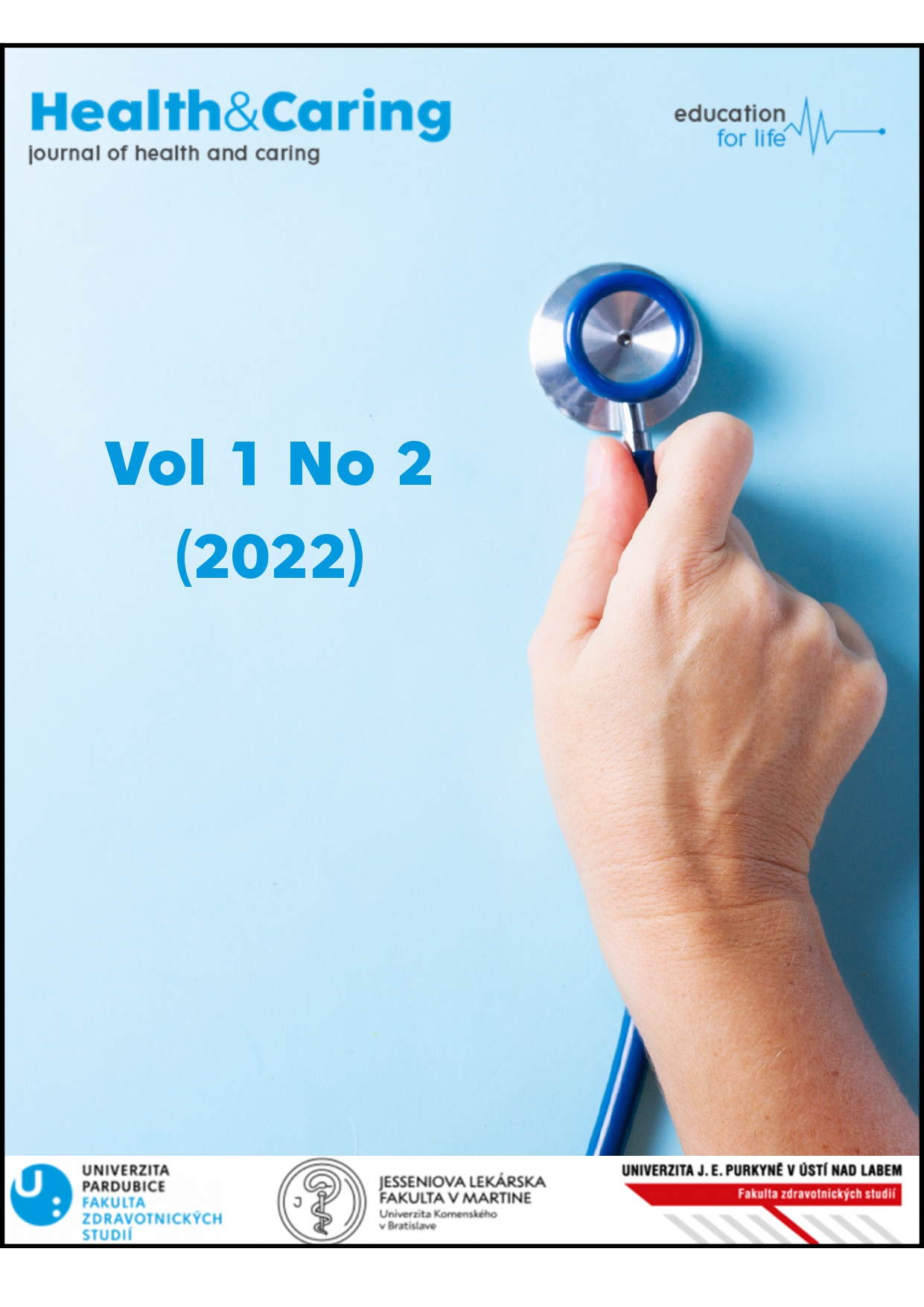OSOBNÁ POHODA OPATROVATEĽOV A KVALITA ŽIVOTA PACIENTOV PO CIEVNEJ MOZGOVEJ PRÍHODE
DOI:
https://doi.org/10.46585/hc.2022.2.2089Abstrakt
Cievna mozgová príhoda (CMP) je často príčinou dlhodobej invalidity. Predstavuje závažný ekonomický, ako aj spoločenský problém tak pre pacienta, ako aj pre jeho rodinu. Prináša zmenu do životov rodín, ktoré musia prispôsobiť mnoho aspektov svojho života chorému členovi. Cieľom štúdie bolo analyzovať vzťah medzi osobnou pohodou opatrovateľov starajúcich sa o pacientov, ktorí prekonali CMP a kvalitou života pacientov po prekonaní CMP. Opatrovateľom bol emitovaný Index osobnej pohody (PWI) a u pacientov Stupnica kvality života pacientov po mozgovej príhode (SS-QOL). Výsledky boli analyzované Pearsonovým korelačným koeficientom. Vo vzorke 64 opatrovateľov a 64 pacientov bol zistený kladný štatisticky významný (p ≤ 0,05) vzťah medzi spokojnosťou so životom ako celkom a postavením v rodine (r = 0,383) rečou (r = 0,257), náladou (r = 0,310), sociálnymi aktivitami (r = 0,298) a prácou (r = 0,248) na stupnici SS-QOL. V tejto oblasti boli zistené aj záporné štatisticky významné vzťahy medzi spokojnosťou so životom ako celkom a pohyblivosťou (r = -0,258) a zrakom (r = -0,247) v rámci stupnice SS-QOL. Rovnako boli zistené kladné štatisticky významné vzťahy medzi osobnou pohodou (celkové skóre PWI) opatrovateľov a postavením v rodine (r = 0,269), rečou (r = 0,296), náladou (r = 0,385), sociálnymi aktivitami (r = 0,290) a prácou (r = 0,281) pacienta. Výsledky naznačujú potrebu ďalšieho výskumu v tejto oblasti, ako aj požiadavku multidisciplinárnych intervencií v starostlivosti o túto komunitu pacientov a ich opatrovateľov.
Stažení
Reference
Almašiová, A., & Kohútová, K. (2016). Štatistické spracovanie dát sociálneho výskumu v programe SPSS. Verbum.
Alotaibi, S. M., Alotaibi, H. M., Alolyani, A. M., Abu Dali, F. A., Alshammari, A. K., Alhwiesh, A. A., Gari, D. M., Khuda, I., & Vallabadoss, C. A. (2021). Assessment of the stroke-specific quality-of-life scale in KFHU, Khobar: A prospective cross-sectional study. Neurosciences (Riyadh, Saudi Arabia), 26(2), 171–178. https://doi.org/10.17712/nsj.2021.2.20200126
Ansari B., & Qureshi, S. S. (2013). Stress and coping in caregivers of cancer patients. Interdisciplinary Journal of Contemporary Research in Business, 4(11), 558-563. http:// ijcrb.webs.com
Asima, M. K., et al. (2015). World Health Organization. (2015). Indonesia: WHO statistical profile. Country Statistics and Global Health Estimates. World Health Organization. Retrieved January 24, 2022, from https://www.who.int/docs/default-source/gho-documents/world-health-statistic-reports/world-health-statistics-2015.pdf
Barello, S., Castiglioni, C., Bonanomi, A., & Graffigna, G. (2019). The Caregiving Health Engagement Scale (CHE-s): development and initial validation of a new questionnaire for measuring family caregiver engagement in healthcare. BMC Public Health, 19(1), 1562. https://doi.org/10.1186/s12889-019-7743-8
Camak D. J. (2015). Addressing the burden of stroke caregivers: a literature review. Journal of Clinical Nursing, 24(17-18), 2376–2382. https://doi.org/10.1111/jocn.12884
Cummins, R. A., Eckersley, R., Pallant, J., Van Vught, J., & Misajon, R. (2003). Developing a national index of subjective wellbeing: the Australian unity wellbeing index. Social Indicator Research, 64, 159–190. https://doi.org/10.1023/A:1024704320683
Cummins, R. A., Li, N., Wooden, M., & Stokes, M. (2014). A demonstration of set-points for subjective wellbeing. Journal of Happiness Studies: An Interdisciplinary Forum on Subjective Well-Being, 15(1), 183–206. https://doi.org/10.1007/s10902-013-9444-9
Cummins, R. A., & Wooden, M. (2014). Personal resilience in times of crisis: The implications of SWB homeostasis and set-points. Journal of Happiness Studies: An Interdisciplinary Forum on Subjective Well-Being, 15(1), 223–235. https://doi.org/10.1007/s10902-013-9481-4
Caro, C. C., Costa, J. D., & Da Cruz, D. (2018). Burden and Quality of Life of Family Caregivers of Stroke Patients. Occupational Therapy in Health Care, 32(2), 154–171. https://doi.org/10.1080/07380577.2018.1449046
Dimunová, L., Sováriová Soósová, M., Kardosová, K., Červený, M., Belovičová, M. (2021). Kvalita života pacientov po cievnej mozgovej príhode. Kontakt, 23(3), 157–161. http://doi.org/10.32725/kont.2020.036
Dou, D. M., Huang, L. L., Dou, J., Wang, X. X., & Wang, P. X. (2018). Post-stroke depression as a predictor of caregivers burden of acute ischemic stroke patients in China. Psychology, Health & Medicine, 23(5), 541–547. https://doi.org/10.1080/13548506.2017.1371778
Faul, F., Erdfelder, E., Buchner, A., & Lang, A.-G. (2009). Statistical power analyses using G*Power 3.1: Tests for correlation and regression analyses. Behavioral Research Methods, 41(4), 1149–1160. https://doi.org/10.3758/BRM.41.4.1149
GBD 2019 Diseases and Injuries Collaborators (2020). Global burden of 369 diseases and injuries in 204 countries and territories, 1990-2019: a systematic analysis for the Global Burden of Disease Study 2019. Lancet (London, England), 396(10258), 1204–1222. https://doi.org/10.1016/S0140-6736(20)30925-9
Gorelick PH (2019). The global burden of stroke: persistent and disabling. The Lancet. Neurology, 18(5), 417–418. http://doi.org/10.1016/S1474- 4422(19)30030-4
Hung, J. W., Huang, Y. C., Chen, J. H., Liao, L. N., Lin, C. J., Chuo, C. Y., & Chang, K. C. (2012). Factors associated with strain in informal caregivers of stroke patients. Chang Gung Medical Journal, 35(5), 392–401. https://doi.org/10.4103/2319-4170.105479
Cheng, H. Y., Chair, S. Y., & Chau, J. P. (2014). The effectiveness of psychosocial interventions for stroke family caregivers and stroke survivors: a systematic review and meta-analysis. Patient Education and Counseling, 95(1), 30–44. https://doi.org/10.1016/j.pec.2014.01.005
Imran, N., Bhatti,R., Haider, I.I, et al. (2010). Caring for the caregivers: mental health, family burden and quality of life of caregivers of patients with mental illness. Journal of Pakistan Psychiatric Society, 7(1), 23–27. Retrived January 24, 2022, from: http://www.jpps.com.pk/article/caringforthecaregiversmentalhealthfamilyburdenandqualityoflifeofcaregiversofpatientswithmentalillness_2396.html
International Wellbeing Group. (2013). Personal Wellbeing Index –Adult (5th ed). Melbourne: Australian Centre on Quality of Life, Deakin University.
Jellema, S., Wijnen, M., Steultjens, E., Nijhuis-van der Sanden, M., & van der Sande, R. (2019). Valued activities and informal caregiving in stroke: a scoping review. Disability and Rehabilitation, 41(18), 2223–2234. https://doi.org/10.1080/09638288.2018.1460625
Khan, A. M., Taj, R., Fatima, A., & Kazmi, S. F. (2015). Quality of Life of Caregivers and Non Carevivers. Annals of Pakistan Institute of Medical Sciences, 11(1), 35–39.
Lu, Q., Mårtensson, J., Zhao, Y., & Johansson, L. (2019). Living on the edge: Family caregivers' experiences of caring for post-stroke family members in China: A qualitative study. International Journal of Nursing Studies, 94, 1–8. https://doi.org/10.1016/j.ijnurstu.2019.02.016
Národné centrum zdravotníckych informácií (2019). Zdravotnícka ročenka Slovenskej republiky 2018. [National Health Information Center in Slovakia]. Retrived January 24, 2022, from: http://www.nczisk.sk/Documents/rocenky/2018/Zdravotnicka_rocenka_Slovenskej_republiky_2018.pdf.
Norrving, B., Barrick, J., Davalos, A., Dichgans, M., Cordonnier, C., Guekht, A., Kutluk, K., Mikulik, R., Wardlaw, J., Richard, E., Nabavi, D., Molina, C., Bath, P. M., Stibrant Sunnerhagen, K., Rudd, A., Drummond, A., Planas, A., & Caso, V. (2018). Action Plan for Stroke in Europe 2018-2030. European Stroke Journal, 3(4), 309–336. https://doi.org/10.1177/2396987318808719
Pacian, A., Kulik, B. T., Bednarz, J., Kaczoruk, M., Kawiak-Jawor, E. (2018). Quality of Life Assessment in Post-Stroke Patients. Pielęgniarstwo XXI wieku, 17(2), 12–22.
Pedersen, S. G., Friborg, O., Heiberg, G. A., Arntzen, C., Stabel, H. H., Thrane, G., Nielsen, J. F., & Anke, A. (2021). Stroke-Specific Quality of Life one-year post-stroke in two Scandinavian country-regions with different organisation of rehabilitation services: a prospective study. Disability and rehabilitation, 43(26), 3810–3820. https://doi.org/10.1080/09638288.2020.1753830
Ptáček, R., Raboch, J. (2010). Určení rozsahu souboru a power analýza v psychiatrickém výzkumu. Česká a slovenská psychiatrie, 106(1), 33–41.
Singhpoo, K., Charerntanyarak, L., Ngamroop, R., Hadee, N., Chantachume, W., Lekbunyasin, O., Sawanyawisuth, K., & Tiamkao, S. (2012). Factors related to quality of life of stroke survivors. Journal of Stroke and Cerebrovascular Diseases, 21(8), 776–781. http://doi: 10.1016/j.jstrokecerebrovasdis.2011.04. 005
Soósová, M. S., Timková, V., Dimunová, L., & Mauer, B. (2021). Spirituality as a Mediator Between Depressive Symptoms and Subjective Well-being in Older Adults. Clinical nursing research, 30(5), 707–717. https://doi.org/10.1177/1054773821991152
Tiwari, S., Joshi, A., Rai, N., & Satpathy, P. (2021). Impact of Stroke on Quality of Life of Stroke Survivors and Their Caregivers: A Qualitative Study from India. Journal of Neurosciences in Rural Practice, 12(4), 680–688. https://doi.org/10.1055/s-0041-1735323
Wild, D., Grove, A., Martin, M., Eremenco, S., McElroy, S., Verjee-Lorenz, A., Erikson, P., & ISPOR Task Force for Translation and Cultural Adaptation (2005). Principles of Good Practice for the Translation and Cultural Adaptation Process for Patient-Reported Outcomes (PRO) Measures: report of the ISPOR Task Force for Translation and Cultural Adaptation. Value in health : the journal of the International Society for Pharmacoeconomics and Outcomes Research, 8(2), 94–104. https://doi.org/10.1111/j.1524-4733.2005.04054.x
Wan-Fei, K., Hassan, S., Sann, L. M., Ismail, S., Raman, R. A., & Ibrahim, F. (2017). Depression, anxiety and quality of life in stroke survivors and their family caregivers: A pilot study using an actor/partner interdependence model. Electronic Physician, 9(8), 4924–4933. https://doi.org/10.19082/4924
Williams, L. S., Weinberger, M., Harris, L. E., Clark, D. O., & Biller, J. (1999). Development of a stroke-specific quality of life scale. Stroke, 30(7), 1362–1369. https://doi.org/10.1161/01.str.30.7.1362
Zahid, M. A., & Ohaeri, J. U. (2010). Relationship of family caregiver burden with quality of care and psychopathology in a sample of Arab subjects with schizophrenia. BMC Psychiatry, 10, 71. https://doi.org/10.1186/1471-244X-10-71.
Stahování
Publikováno
Jak citovat
Číslo
Sekce
Licence
Copyright (c) 2022 Valéria Parová

Tato práce je licencována pod Mezinárodní licencí Creative Commons Attribution-NonCommercial 4.0.
Přijat 2022-08-30
Publikován 2022-09-30










